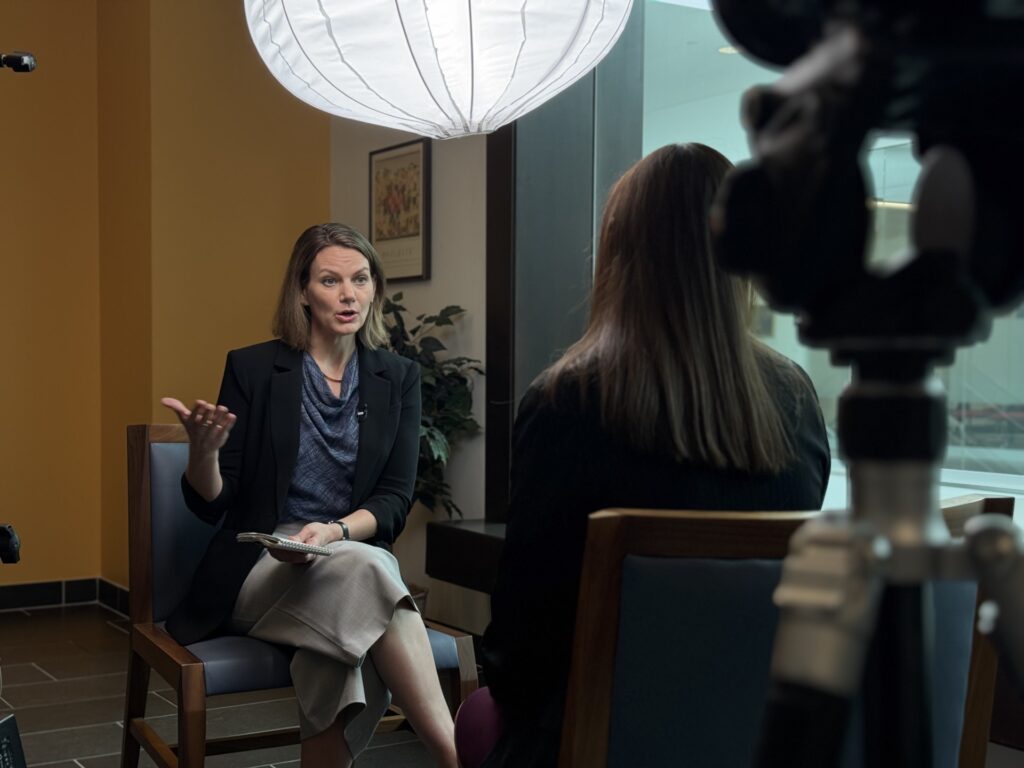Sarah Varney ’91: Reporter at large

Sarah Varney ’91 tells stories at the intersection of law and women’s health.
As a youth in the early 1980s, Sarah Varney ’91 spent hours lying on her liv-ing room floor, listening to New Hampshire Public Radio. Radio was the sole entertainment at home and, unlike most contemporary media, it featured women’s voices: Linda Wertheimer, Susan Stamberg and eventually Nina Totenberg, “the founding grandmothers of NPR,” she says.
“It wasn’t just that I was hearing their voices,” she says of NPR’s women. “It was that the stories they were interested in were totally different than the stories men were interested in.
… I didn’t know exactly what a journalist was. But whatever it was they were doing, that’s what I wanted to do.”
After studying public policy and political science at Brown, she covered news and health for public radio, ultimately becoming a special health care correspondent for PBS NewsHour and a contributing health reporter for NPR. Collectively, her reportage covers modern American medical history, including the HIV and opioid epidemics and the Affordable Care Act.
Her pieces put personal narratives within a larger context, taking into account the broader chessboard at play. “We’re taking on these big ideas,” she says, “then rooting them in actual day-to-day stories.”
For one segment, she interviewed a woman who, prevented by Tennessee law from ending her pregnancy, delivered an infant with organs outside the body. It was a profoundly poignant tale. “Even for people opposed to abortion, I think hearing this woman’s story couldn’t not be moving,” Varney says.
At the same time, the story highlighted the intersection of state law and women’s health. “We talk about abortion bans in the abstract,” Varney says. “I’m in the field trying to find real people impacted by these policies.” Because some 2 mil-lion viewers watch NewsHour nightly, including members of Congress and Supreme Court justices, she can “share these stories with people who make really important decisions.”
Varney sees her role as a “collector of stories,” entrusted with people’s experiences at moments of extreme vulnerability. “I think human beings are inherently wired to want to listen,” she says. “Hearing people’s stories and why they make the decisions they make, or believe what they believe, then sharing these stories with [others] is extremely important. It’s how we’re connected as human beings, through storytelling.”

Reporters must also ask difficult questions. For one piece, Varney interviewed an influential anti-abortion activist who didn’t want to discuss her opposition to contraception. “That’s why it’s even more important,” Varney says, “to have a journalist sit down and say: ‘Your logic is that if a form of contraception prevents a fertilized egg from possibly implanting in the uterus, that’s an abortion. Under Texas law, that makes any form of birth control an abortifacient. Is that true?’ It’s up to them to say, ‘Yes, that’s my logic.’ I think the reason journalists are really important at this moment is we’re not activists.”
Last year, after completing a Nieman Fellowship at Harvard, Varney created Fountain Productions, a nonprofit dedicated to independent journalism on the consequences of the 2022 Supreme Court decision overturning Roe v. Wade. Roe v. Wade established the constitutional right to abortion in 1973.
“There’s been a lot of great journalism about the seismic shift in reproductive rights in American life in print and radio, but [no] consistent place to do this on television,” she says. She and her small team produce NewsHour segments and are creating two podcasts, Caged: The Origins of Patriarchy and Body and State, based on NewsHour interviews.
Varney is also gathering stories of women affected by abortion bans into a multimedia repository that will be available to news organizations. “You’ll have extraordinary reporting done about one person in Texas, then another powerful story about one person in Tennessee,” she says. “How do you start to pull them together?”
Her work may help to inspire the next generation of reporters covering women’s health.
This story was originally published in the Summer 2025 issue of The Exeter Bulletin.